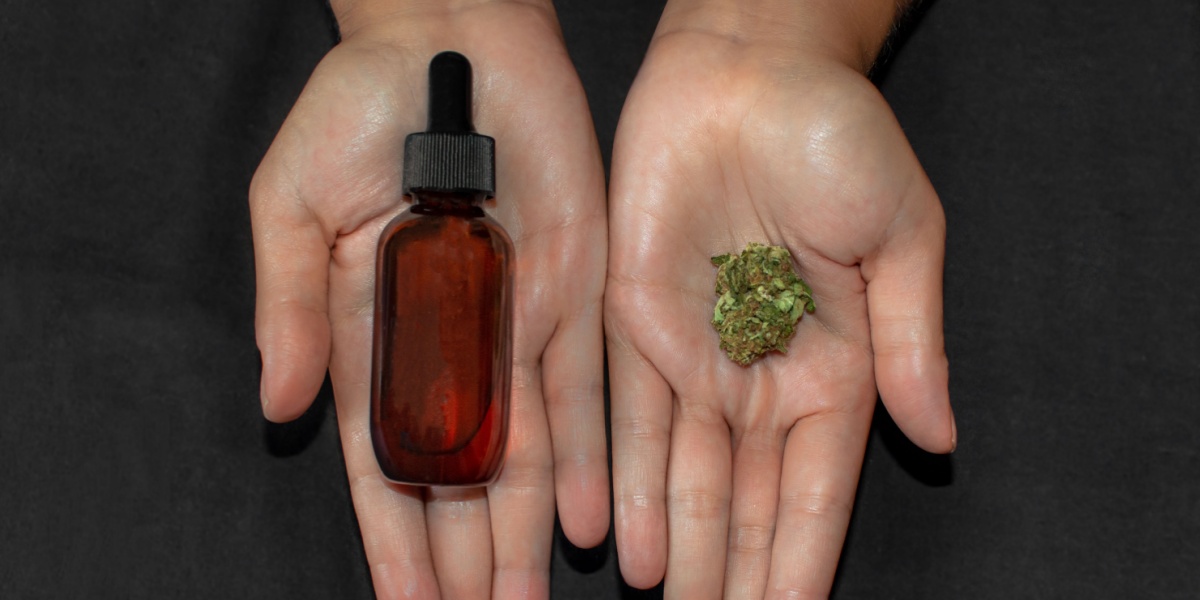As the legal status of cannabis is changing across the US, there has been an increase in the availability and use of cannabinoids (the active ingredients in the cannabis plant). As more research is done, we’re able to see the potential benefits of some of these compounds.
We’re going to look at two similar cannabinoids, cannabinol (CBN) and cannabidiol (CBD). Where CBD is relatively well-understood, many people may be less familiar with CBN.
- CBN and CBD have similar therapeutic effects, including pain relief, sleep support, and anxiety reduction, but CBN is less researched than CBD.
- Both CBN and CBD are non-intoxicating, but CBN is derived from THC and has mild psychoactive effects, whereas CBD is completely non-psychoactive.
- CBD is widely studied and FDA-approved for some uses, while CBN remains under-researched with no FDA-approved applications yet.

Understanding CBN and CBD
CBN and CBD are cannabinoids found in the cannabis and hemp plants. While they share many similarities, they have some important differences to understand.
The similarities between CBN and CBD
CBN and CBD share important characteristics:
The differences between CBN and CBD
Presented next are some important differences between CBN and CBD.[1][2][4]
How do CBN and CBD differ from THC
CBN and CBD are very different from THC, which is the cannabinoid responsible for the psychoactive effects of cannabis, especially the euphoric high.
Although CBN has some minimal psychoactive effects, neither of these two substances are considered capable of creating a high, and they are not associated with other psychoactive effects.
Benefits of CBN and CBD
Although cannabis and cannabinoids are generally considered recreational drugs, CBD, in particular, is widely used to treat a variety of medical conditions. Almost 62% of people using CBD report doing so to treat a medical condition, including pain, anxiety, and depression. Of those, over 35% said that CBD is an effective treatment “by itself”.[5]
CBN has not been as widely studied or used as CBD, but it shows signs of having similar properties, and research into its use is increasing.
Here are some of the most common beneficial uses of CBN and CBD.
Pain management
CBD and CBN appear to be effective at reducing pain. Animal studies suggest that taking both of them together may have a greater effect, and this effect appears to be replicated in humans.[4][6]
Sleep aids
CBD and CBN have reported efficacy for improving sleep. However, further research is required to understand whether it is specifically helpful for patients with insomnia.[7]
Studies investigating the effects of CBN on sleep are rare, but there is some evidence that it may reduce how easily sleep is disturbed, though this did not appear to translate into participants feeling less tired during the day.[8]
Anxiety/stress relief
CBD and CBN have been marketed for the treatment of anxiety and stress. There is very little research into the effect of CBN alone on people experiencing anxiety or stress.
CBD can be effective in the outpatient treatment of anxiety with or without associated insomnia.[9] It also may be helpful for patients with PTSD.[10]
Inflammation
Another important benefit of CBN and CBD is in reducing inflammation, which may be used to treat conditions such as arthritis. Current studies show that CBD and CBN reduce inflammation from arthritis in animal models.[11] Neither substance is approved for use in humans for this purpose.
Tumors
CBD, in particular, appears to have a significant anti-cancer effect. In animal models, it inhibits metastasis (the development of secondary tumors in other areas of the body) and reduces the invasiveness of tumors. It also appears to cause selective cell death of cancer cells.[12][13]
CBN has shown promise in treating cancers, including leukemia.[14]
Other benefits
CBN can delay the onset of amyotrophic lateral sclerosis (ALS), a form of motor neuron disease in mouse models, although this has not yet been tested in humans.[15]
CBD is effective at treating refractory seizures from a number of specific conditions found primarily in young children.[2] These seizures do not respond well to other forms of treatment.
CBD is currently being investigated for its effects on neurodegenerative diseases, such as Alzheimer's disease and Parkinson's disease.[2]
CBD and THC taken together may be an effective treatment for migraines; CBN may be able to treat the symptoms of ADHD.[16][17]
Are there any risks to using CBN and CBD?
As with all drugs, CBN and CBD come with risks of side effects and adverse events.
Again, we have more information about the risks of CBD than CBN because it has been more widely studied.
When taken for pain following kidney transplant, common side effects of CBD included nausea, dry mouth, dizziness, drowsiness, and intermittent periods of feeling hot.[18] Other side effects regularly reported include tiredness and diarrhea. For the conditions it is used to treat, the side effects of CBD are typically less than alternative, more commonly used drugs.[19]
In high dosages, CBD can cause liver damage. It may also lead to sedation and suicidal thoughts. It is possible that new side effects and risks will become apparent as CBD becomes more commonly used and more research is carried out.[2]
What forms do CBN and CBD come in?
CBD and CBN are available in different forms. As the more common product, CBD offers more choice to consumers.
Both CBD and CBN can be found in these forms:
- Oils
- Teas
- Tinctures
- Vapes
- Pills/capsules
CBD is also commonly found in other products, such as:
- Gummies, chocolates and other edibles
- Creams
- Shampoos
Because of the similarities between CBD and CBN, they are both capable of being used in the same ways. Differences between the forms available are due to economics, rather than medicinal factors.
Are CBN and CBD legal?
CBD and CBN are currently legal in the US. If supplied as a plant or plant extract, the level of THC must remain below 0.3% to be legal under federal law. THC levels that exceed this may be legal under state law, but this will differ by state.[20]
Final thoughts
CBN and CBD are both legal substances that have the potential to offer therapeutic benefits, although it is not entirely certain which benefits will be confirmed by rigorous scientific research.
Given the uncertainty surrounding these substances, it is important to speak with your doctor or healthcare practitioner to discuss your plans for use and the underlying conditions you are treating.
There are also concerns about the purity and testing regimes of these products. For legal products containing THC, research shows that the majority fail to test for impurities and offer inaccurate information about dosages to customers.[20]
Dosage is particularly important for these substances, as they appear to show a bell-curve effect. This means that increasing the dose doesn’t always increase the effect. In some cases, once the peak effect has been achieved, increasing doses further can decrease the effect.[21]

-person-thumbnail.jpg?v=1758880627)

-guide-detail.jpg?v=1756808755)
-guide-detail.jpg?v=1756808779)